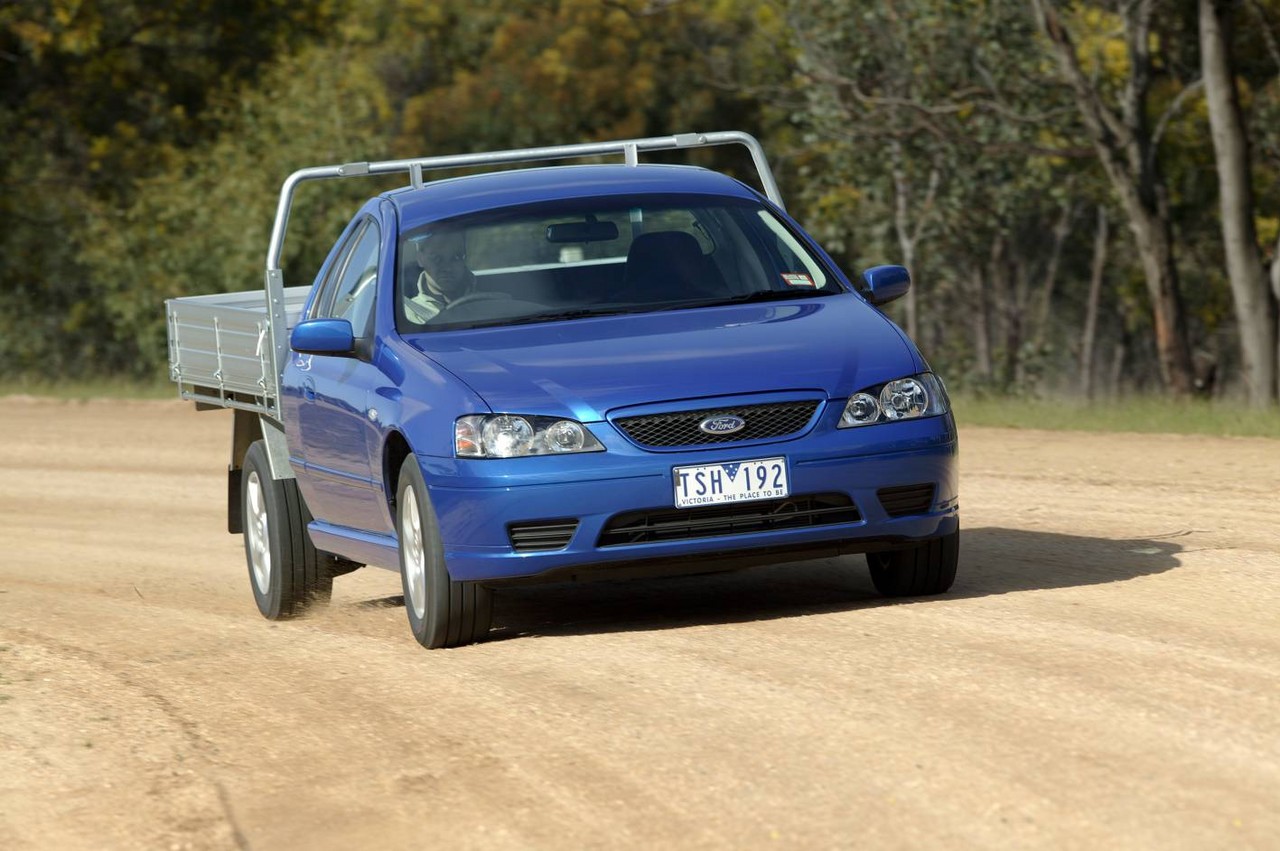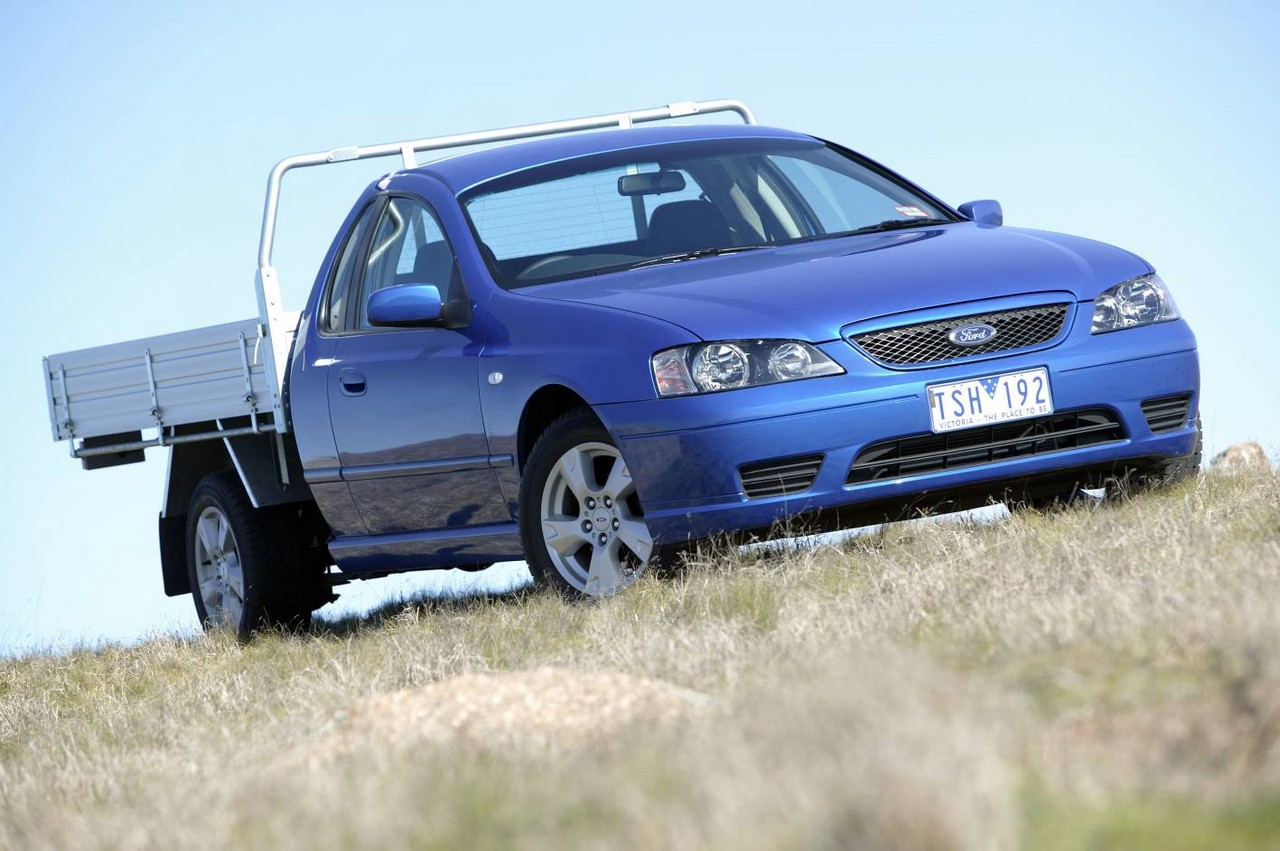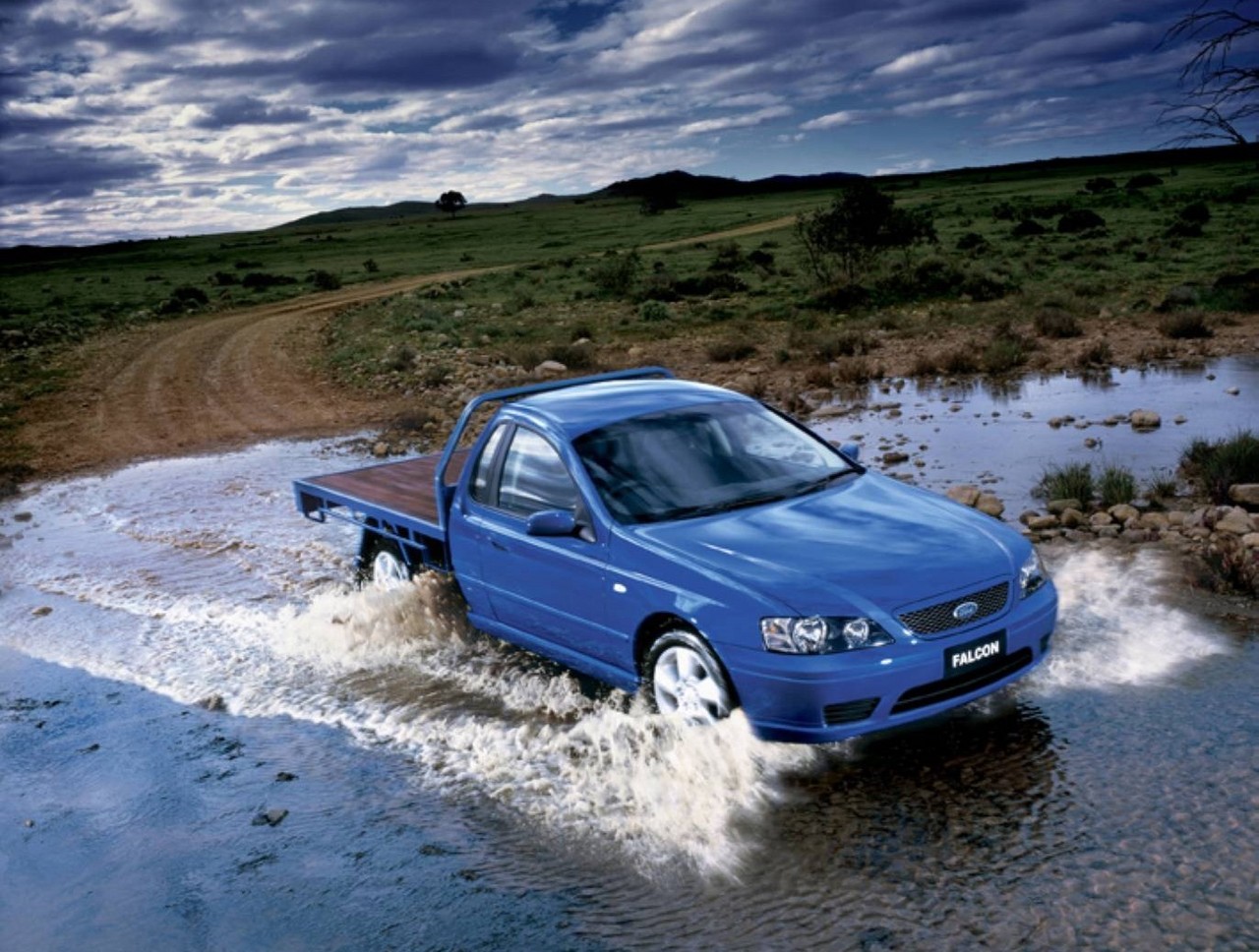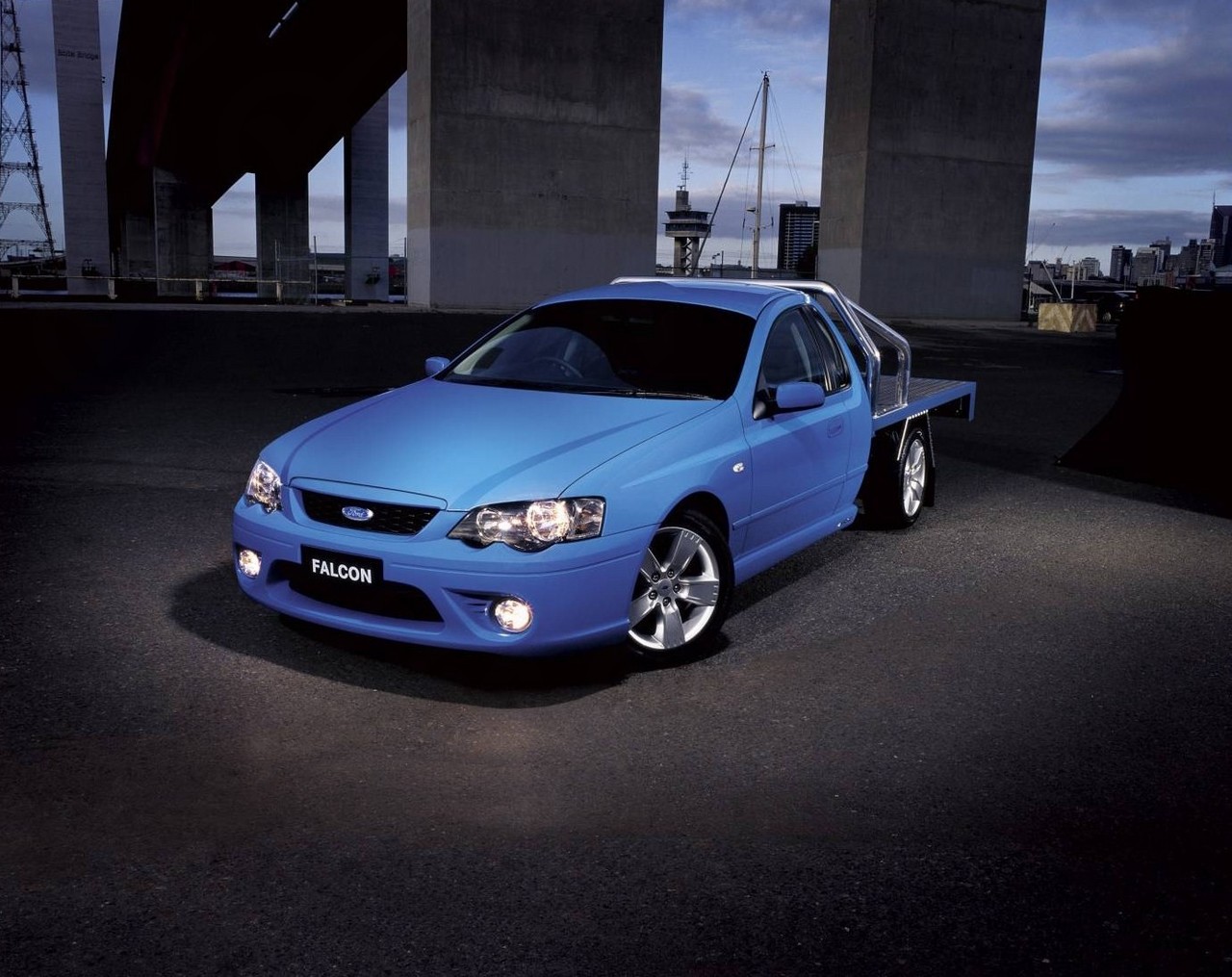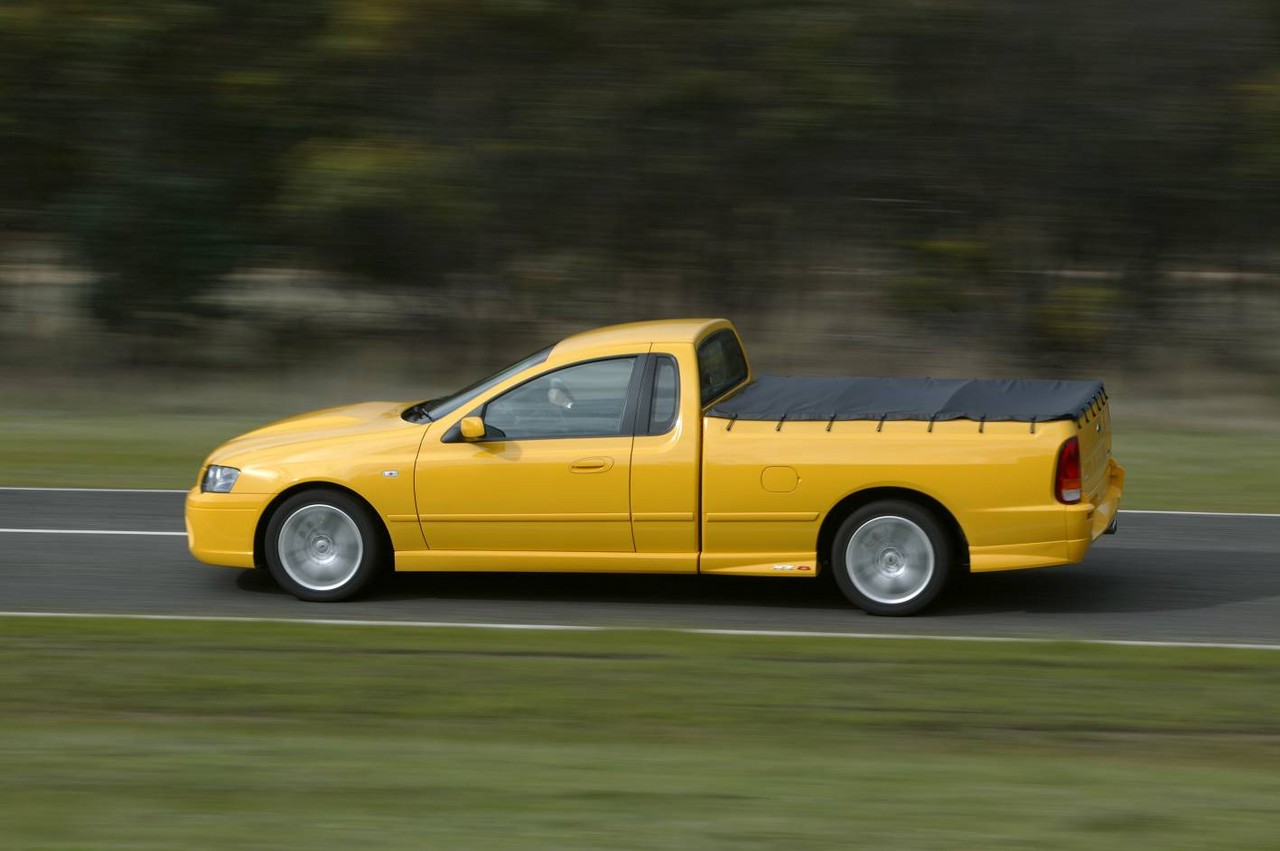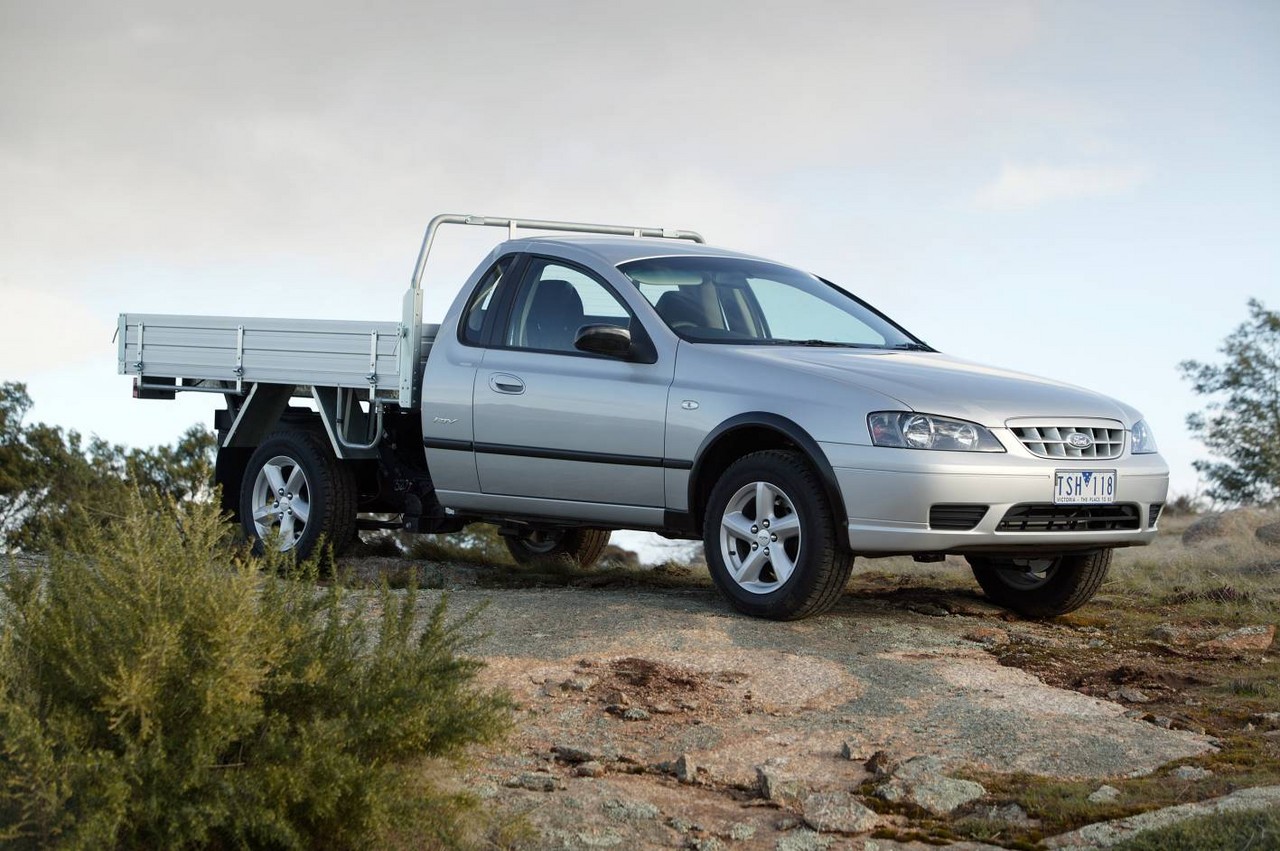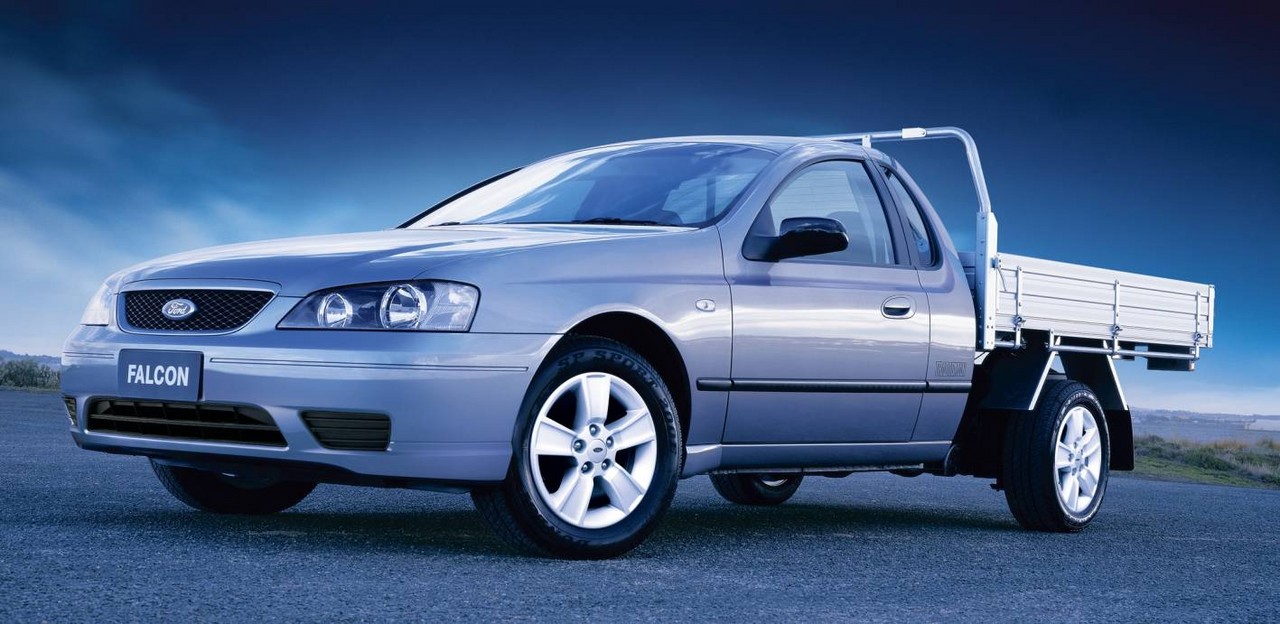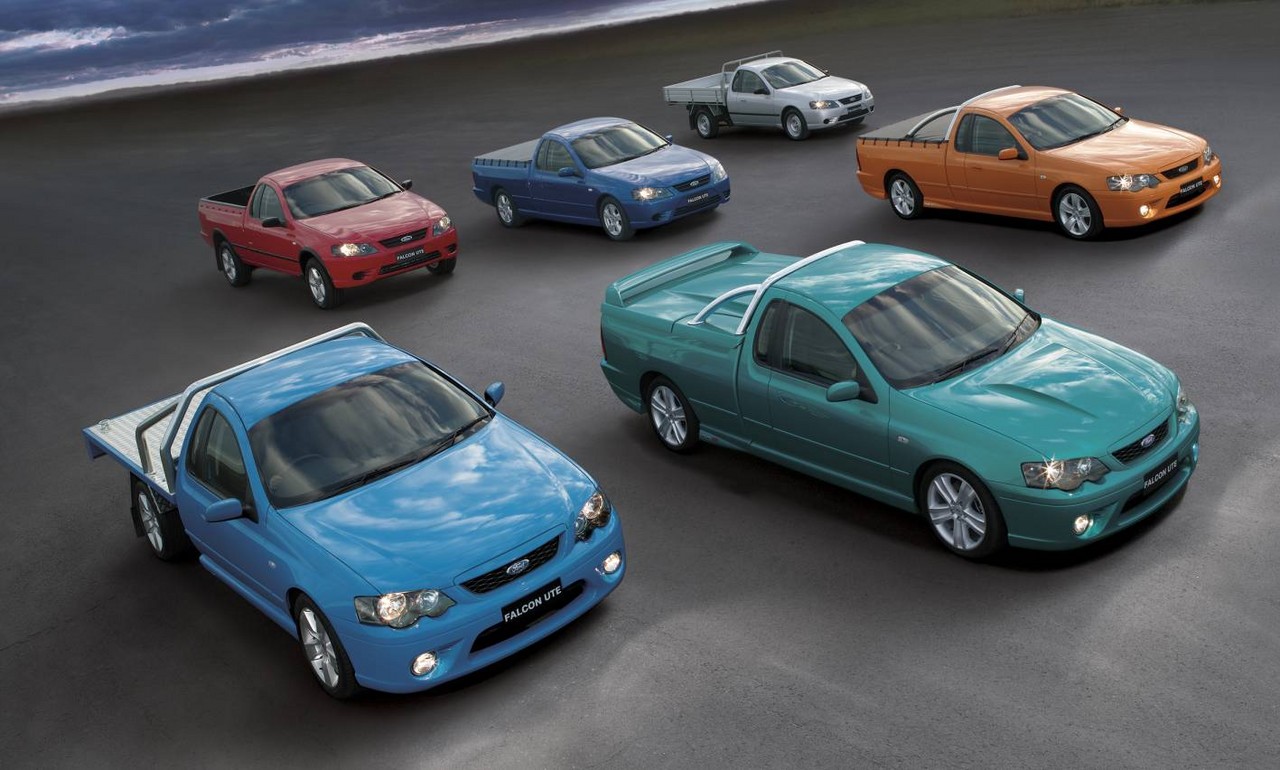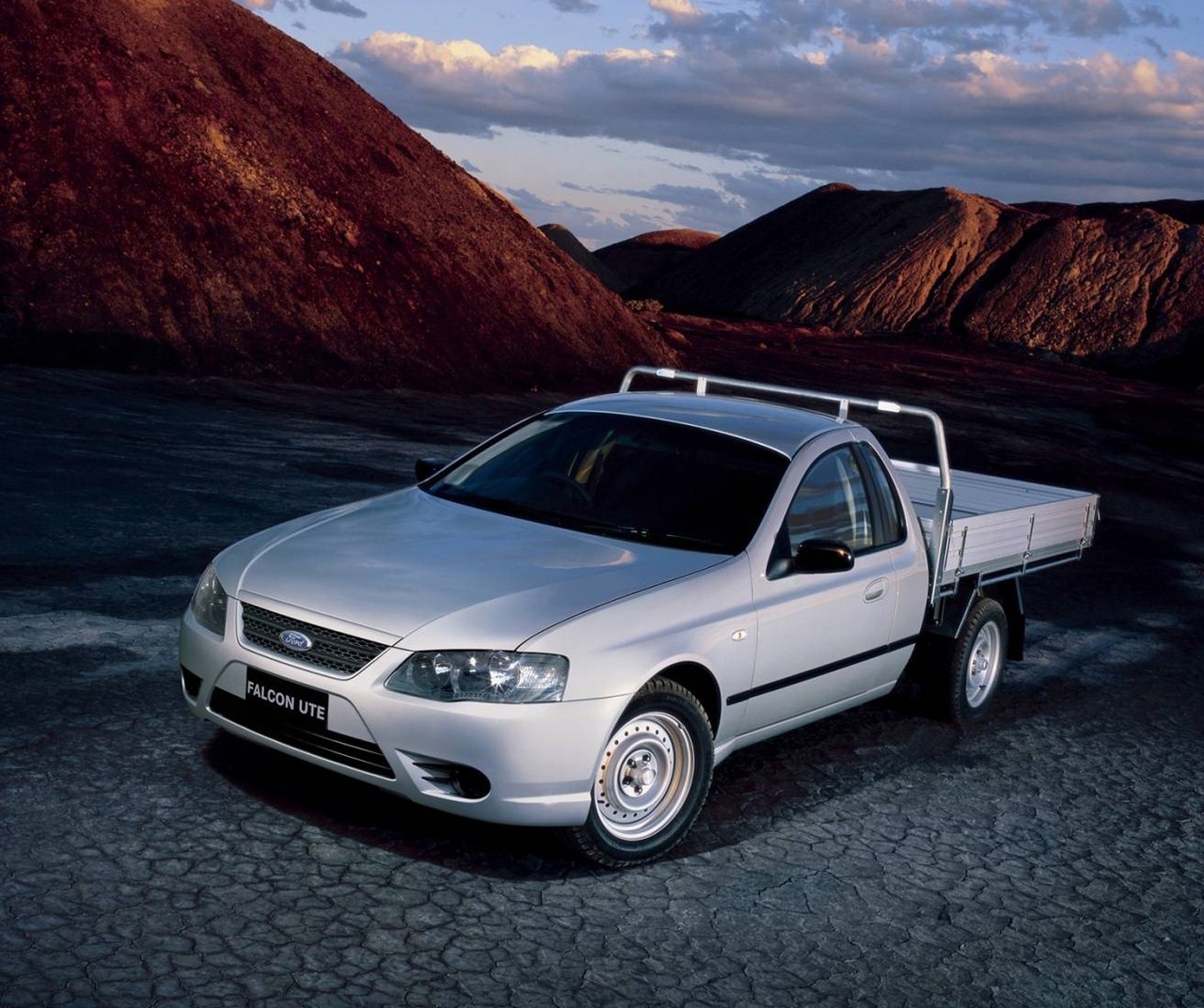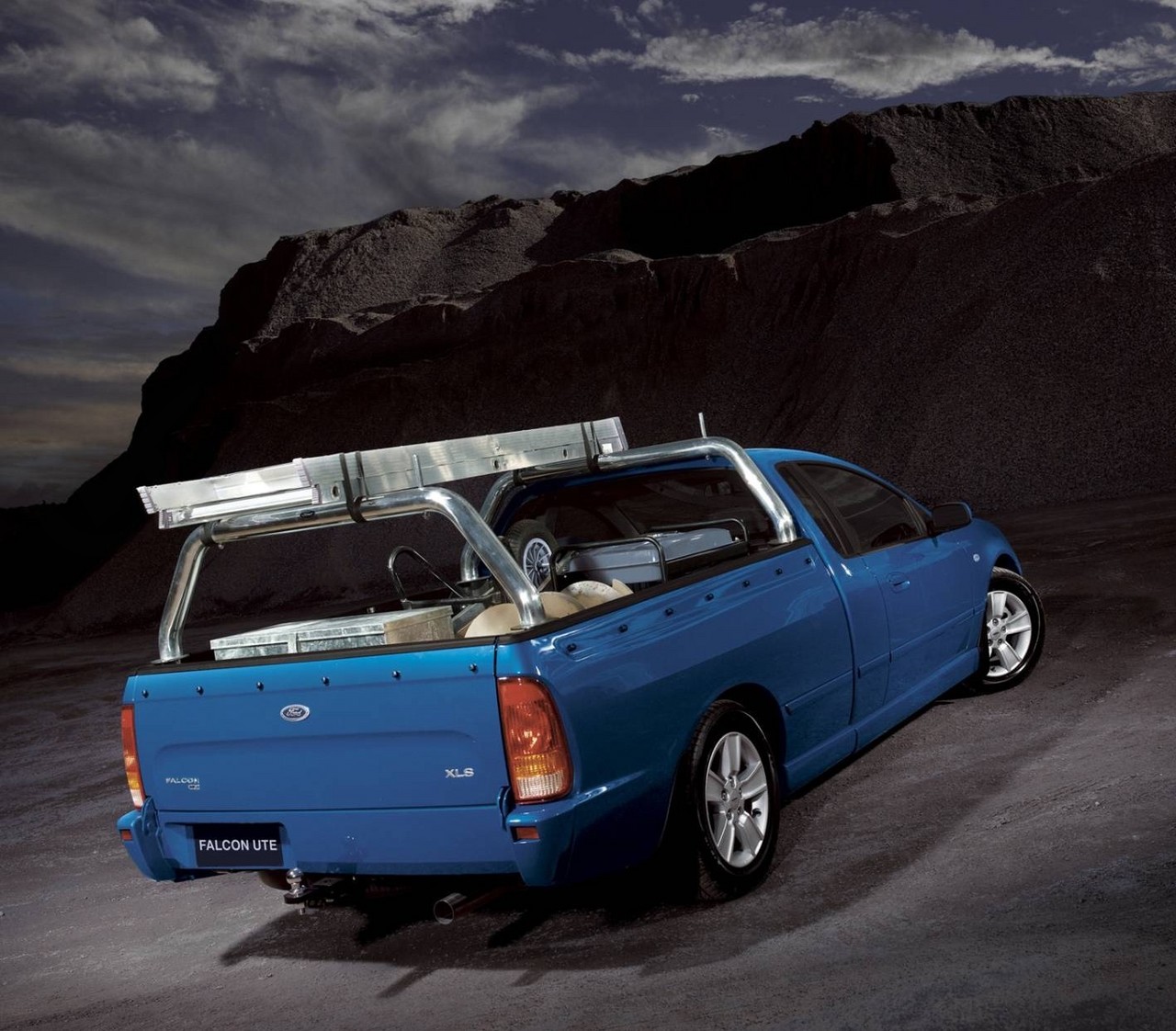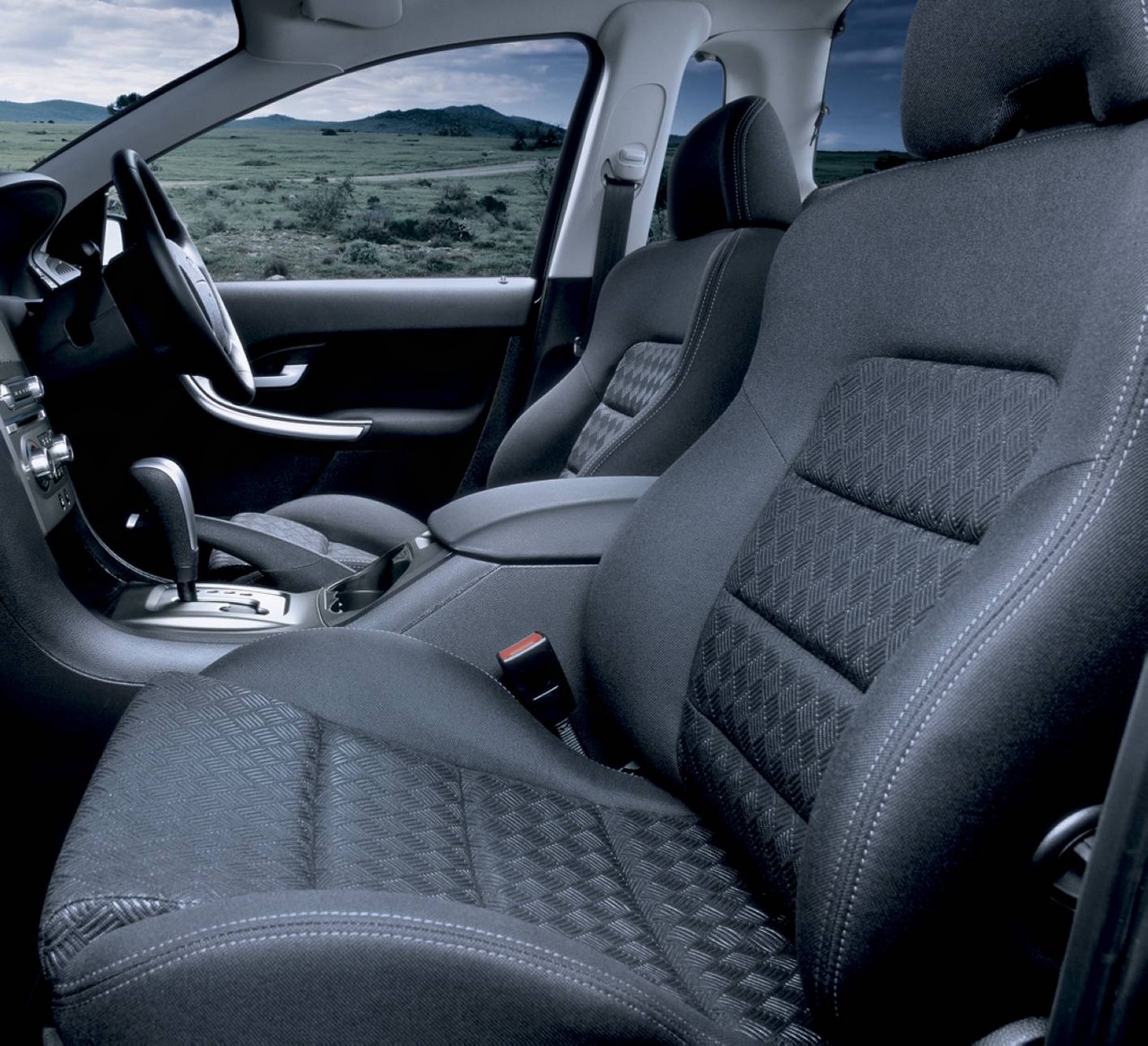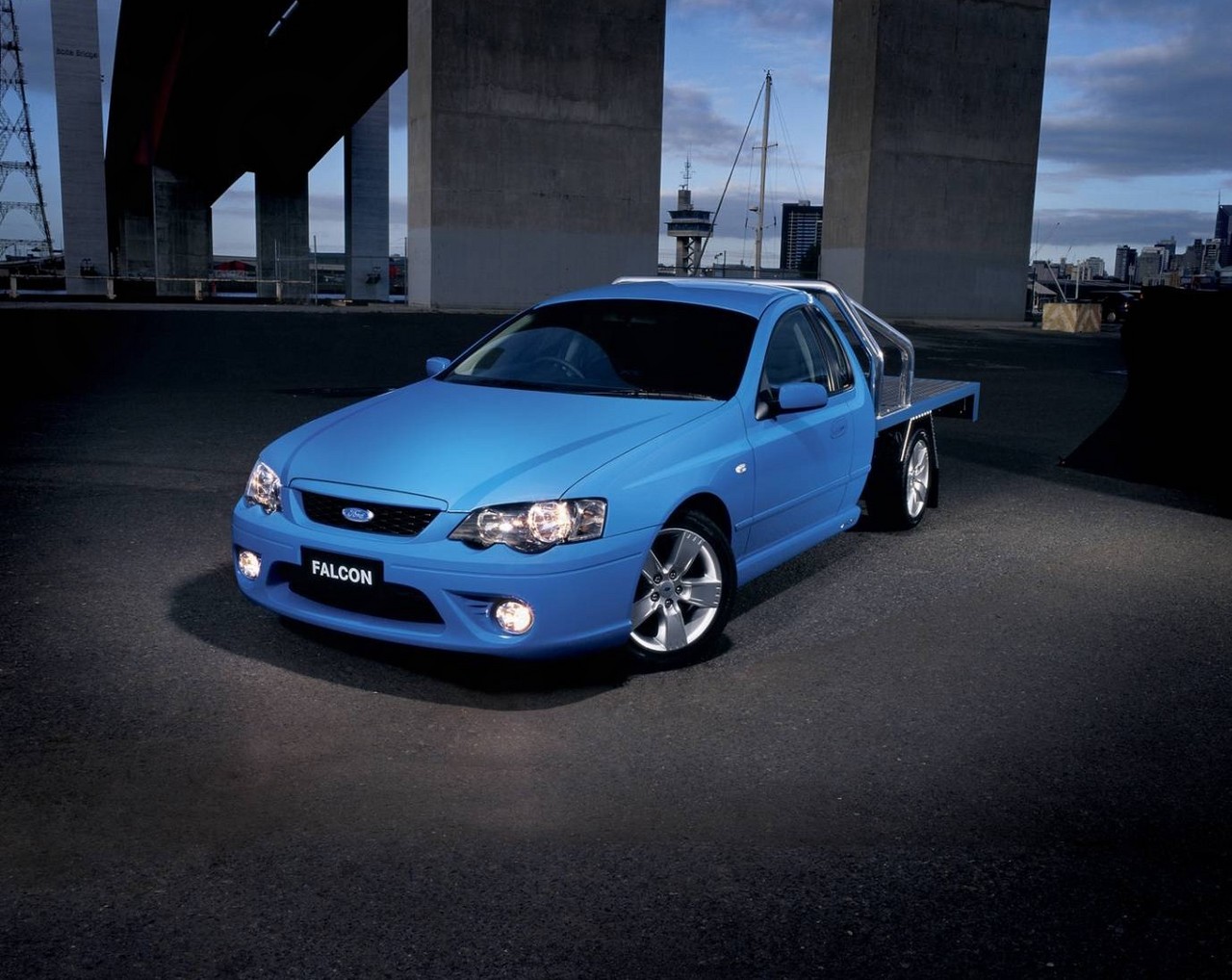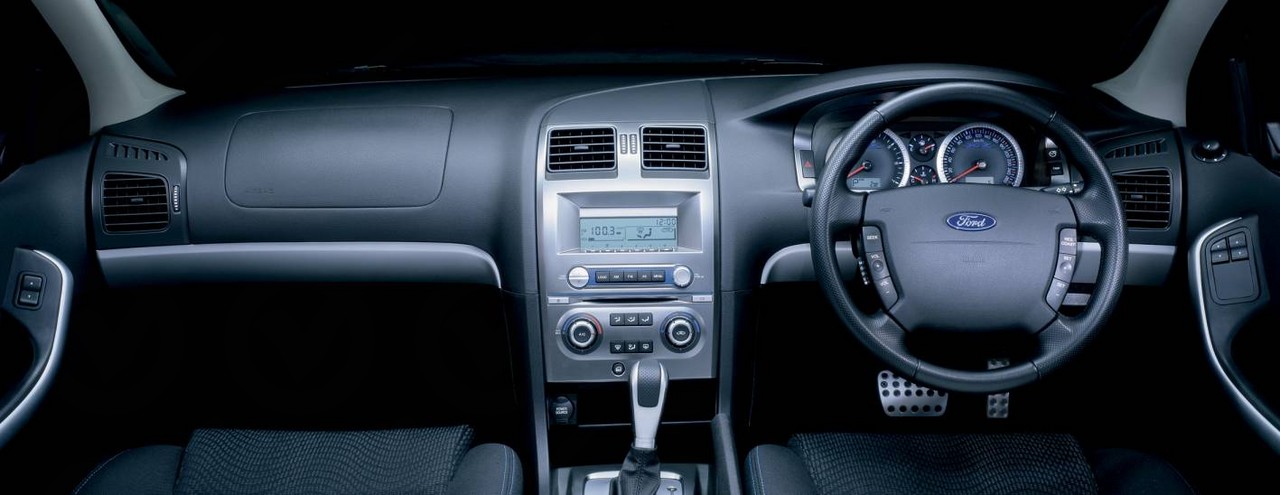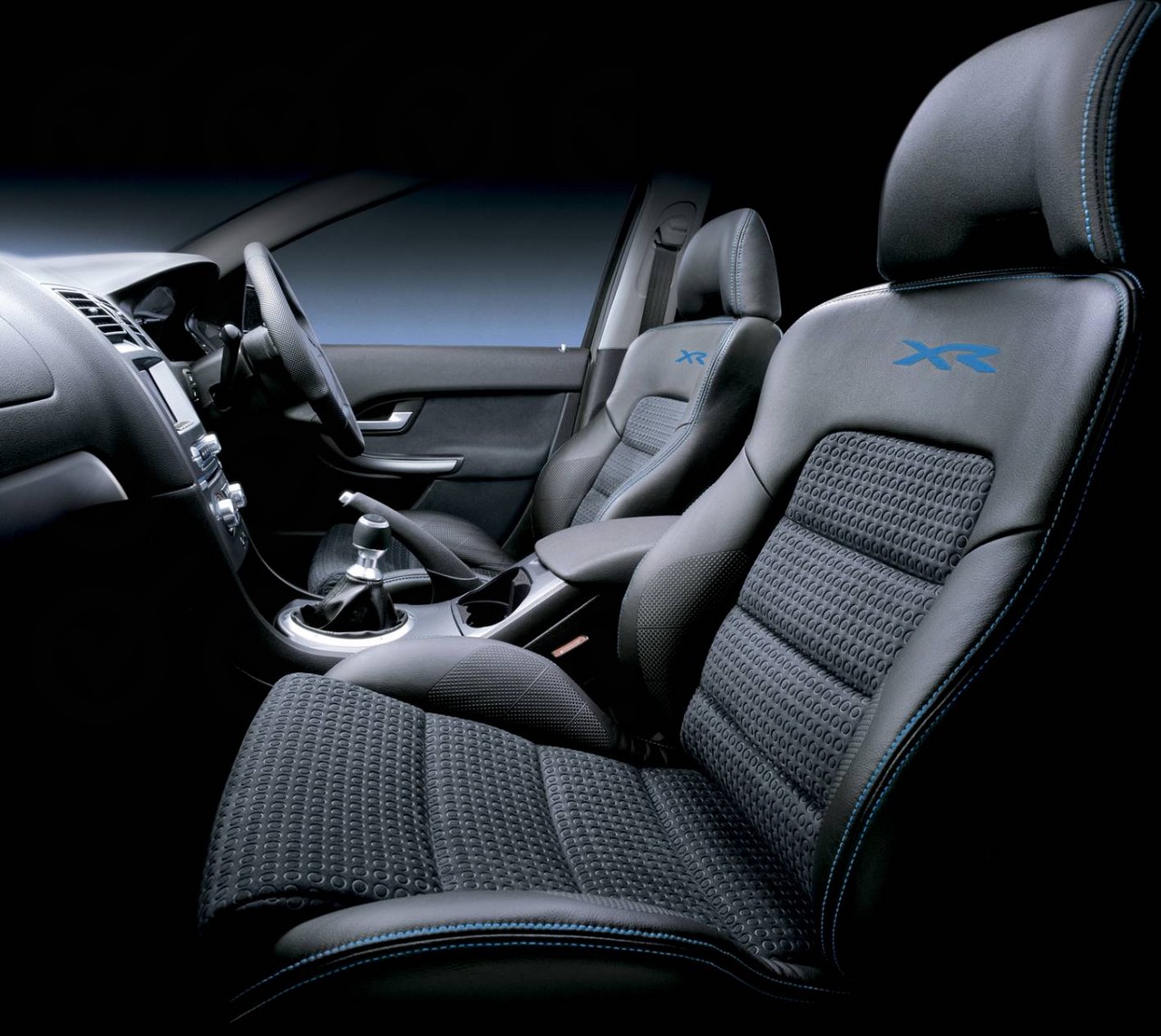
- Responsive and refined 4.0-litre six-cylinder engine
- Powerful engines for XR6 Turbo and XR8
- Accomplished ride/handling balance
- Spacious cabin is well-insulated
- Steering provides good feedback
- Refined six-speed ZF automatic transmission
- Limitations of leaf spring rear suspension on uneven surfaces
- Cast-iron 4.0-litre engines are heavy and not particularly fuel-efficient
- Variable build quality
- Coolant lines for automatic transmission cooler susceptible to failure
Review: Ford BF.I Falcon Ute (2005-06)
Overview
Released in October 2005, Ford BF Mark I (BF.I) Falcon Ute was available with either a cab chassis or integrated Styleside box body. Manufactured in Campbellfield, Victoria, the rear-wheel drive BF.I Falcon Ute was available with 4.0-litre inline six cylinder engines (naturally aspirated and turbocharged) and 5.4-litre petrol V8 engines. As per the table below, the BF.I Falcon Ute range initially consisted of XL, XLS, RTV, XR6, XR6 Turbo and XR8 variants.
Engines: Barra 190, Barra 245T, E-Gas, Barra 220 and Boss 260
Of the engines,
- The 4.0-litre Barra 190 inline six-cylinder petrol engine had a cast iron block, a cast aluminium cylinder head, double overhead camshafts (DOHC, simplex chain-driven), dual independent variable camshaft timing, four valves per cylinder, Duratec-style finger followers, a dual resonance inlet manifold, coil-on-plug ignition, electronic throttle control, exhaust gas recirculation and a compression ratio of 10.3:1. Compared to its Barra 182 predecessor, changes for the Barra 190 engine included independent variable camshaft timing (i.e. each phaser could rotate each camshaft independently), a revised camshaft profile, a second knock sensor so that ignition timing could be optimised for each cylinder, revised piston crown profiles for a higher increased compression ratio, lower viscosity engine oil (5W30 GF3, previously 10W30 GF2), a lighter driveplate assembly, a new air intake and a revised exhaust system (with a new front resonator and retuned centre and rear mufflers);
- For the Falcon Ute XR6 Turbo, the Barra 245T engine added a Garrett GT3582R turbocharger which had engine oil-lubricated and water-cooled bearings, an air-to-air intercooler and an electronic single bypass wastegate. The turbocharger was mounted off a cast stainless steel exhaust manifold and provided maximum boost pressure of 6 psi (0.413 bar). Compared to the Barra 190 engine , the Barra 245T engine had ‘dished bowl’ shaped pistons, more temperature tolerant exhaust valves and increased fuel pressure (4.0 bar, compared to 2.4 bar). Like the Barra 190, however, the Barra 245T engine benefited from dual independent variable cam timing (VCT), a revised camshaft profile and dual knock sensors.
- Compared to the Barra 190 engine, the 4.0-litre Barra E-Gas dedicated LPG engine had a Vialle closed-loop single-point carburetion system, a compression ratio of 10.3:1 and hardened valves and valve seats. For the BF range, the E-Gas engine had a lower compression ratio since it shared its pistons with the Barra 190 engine , had a revised venturi (for better air/fuel mixing), throttle body and inlet pipe, and satisfied Euro III emissions standards;
- The 5.4-litre Barra 220 V8 engine had a cast iron block, a cast aluminium cylinder head, sintered connecting rods, a single overhead camshaft (SOHC), variable intake camshaft timing (over 60 degrees relative to the crankshaft), three valves per cylinder (two intake, one exhaust), roller finger followers, coil on plug ignition and a compression ratio of 9.7:1; and,
- Assembled by hand in Campbellfield, the 5.4-litre Boss 260 V8 engine had double overhead camshafts, four valves per cylinder and a compression ratio of 9.52:1, but omitted the variable cam timing of the Barra 220 . The Boss 260 engine combined the long stroke 5.4-litre block with Mustang Cobra R heads and changes included high-lift camshaft profiles, specific inlet camshaft to match the high-rise inlet manifold and exhaust header system, forged steel crankshaft, Boss fuel rail with upgraded injectors, 75 mm throttle body, low-restriction air-intake with a conical filter, 1 7/8inch stainless steel exhaust headers and an FPV oil pan and oil pick-up.
For the BF range, ‘transient’ rpm limits were introduced for the six cylinder engines which momentarily allowed engine speed to exceed the prescribed rev limit during upshifting – this enabled wide open throttle upshifting to occur at an engine speed closer to the rev limiter than would otherwise be possible.
Transmissions
Of the transmissions,
- The naturally aspirated six-cylinder engines were available with four-speed BTR M93LE (also known as ION 93-4AT) automatic, five-speed BTR T5 manual transmissions or six-speed Tremec T56 manual transmissions (the latter reserved for the XR6); and,
- The XR6 Turbo and XR8 were available with six-speed ZFHP26 automatic or six-speed Tremec T56 manual transmissions.
For the BF range, the four-speed BTR M93LE automatic transmissions were upgraded with:
- Stronger gearsets;
- Radial dead-end groove clutch plates and a second ‘Ball Check valve’ in the valve body for improved oil flow;
- The introduction of Grade Control Logic (previously introduced in the SX Territory );
- An accelerator pedal detent and kickdown switch;
- Revised software for improved shift schedules; and,
- Calibration improvements for more refined and consistent shift feel.
First introduced in the BMW E65 and E66 7-Series , the six-speed ZF 6HP26 automatic transmission was available in two versions: a standard version with a torque capacity of 450 Nm and a high-performance 600 Nm version (for use with the Barra 230, Barra 245T and Boss 260 engines) which had upgraded clutches with extra plates in the clutch packs. For its use in the BF Falcon, hardware changes for the ZF 6HP26 transmission included a unique transmission main case, torque converter, output/driveshaft flange and a new transmission cross member attachment (shared with the four-speed automatic). The ZF transmission featured adaptive ‘Driver Recognition’ behaviour, including brake support downshifts, gear holding when cornering, gear holding for uphill and downhill driving and gear holding for fast-off throttle driving situations.
For all automatic transmissions, a new remote transmission oil cooler (RTOC) – with a three-way coolant thermostat – was mounted to the engine block. Acting as a heat exchanger, coolant lines (or tubes) passed through the radiator to warm-up the transmission fluid on start-up and provide cooling under high load/high temperature operating conditions.
Development and dimensions
Since the BF Falcon Ute had the same platform as its BA Falcon Ute predecessor, greater refinement was a significant objective in its development. To this end, the following changes were made:
- The introduction of a two-piece, lofted outer dashboard;
- The addition of bitumastic pads to the body for damping of low- and mid-frequency noises;
- The introduction of an absorptive roof-liner;
- Improved static sealing;
- Body structure improvements through the fitment of a reinforcing box section to the transmission cross member and centre bearing body reinforcement;
- New engine and transmission mounts; and,
- Redesigned exhaust hangers to isolate muffler vibration from the body.
Other developments for the BF range included:
- The introduction of Bosch ABS 8.0 (previously 5.3) which included electronic brake force distribution;
- An upgraded traction control system and the introduction of electronic stability control and cornering brake control;
- A revised pedal map for the electronic throttle control; and,
- A higher-output alternator for improved fuel economy, lower rotational speeds and lower fan speeds.
The BF Falcon Ute had the same dimensions as the BA Falcon Ute such that the BF Styleside utility was 4938 mm long, 1870 mm wide, 1515 mm tall and had a 3096 mm long wheelbase. Compared to its BA predecessor, the BF Falcon Ute could be identified by its deeper front bumpers and new wheel covers and alloy wheel designs. Inside, all BF Falcon Utes were fitted with soft-feel door grab handles with satin chrome inserts and new seat fabrics, fabric inserts and door trims.
Suspension
The BF Falcon Ute had double wishbone front suspension and a live rear axle that was suspended by leaf springs.
| Body | Variant | Engine | Trans. | Peak power | Peak torque |
|---|---|---|---|---|---|
| Cab chassis | XL, Tradesman, XLS, RTV |
4.0-litre Barra 190 petrol I6 | 4sp auto, 5sp man. |
190 kW at 5250 rpm | 383 Nm at 2500 rpm |
| 4.0-litre Barra E-Gas LPG I6 | 4sp auto, 5sp man. |
156 kW at 5000 rpm | 374 Nm at 2750 rpm | ||
| 5.4-litre Barra 220 petrol V8 | 4sp auto, 5sp man. |
220 kW at 4750 rpm | 470 Nm at 3250 rpm | ||
| XR6 (Special Edition) | 4.0-litre Barra 190 petrol I6 | 4sp auto, 5sp man. |
190 kW at 5250 rpm | 383 Nm at 2500 rpm | |
| Utility | XL, SE, XLS, RTV |
4.0-litre Barra 190 petrol I6 | 4sp auto, 5sp man. |
190 kW at 5250 rpm | 383 Nm at 2500 rpm |
| 4.0-litre Barra E-Gas LPG I6 | 4sp auto, 5sp man. |
156 kW at 5000 rpm | 374 Nm at 2750 rpm | ||
| 5.4-litre Barra 220 petrol V8 | 4sp auto, 5sp man. |
220 kW at 4750 rpm | 470 Nm at 3250 rpm | ||
| XR6 | 4.0-litre Barra 190 petrol I6 | 4sp auto, 5sp man. |
190 kW at 5250 rpm | 383 Nm at 2500 rpm | |
| XR6 Turbo | 4.0-litre Barra 245T turbo petrol I6 | 6sp auto, 6sp man. |
245 kW at 5250 rpm | 480 Nm at 2000-4500 rpm | |
| XR8 | 5.4-litre Boss 260 petrol V8 | 6sp auto, 6sp man. |
260 kW at 5250 rpm | 500 Nm at 4250 rpm |
Safety equipment
Standard safety equipment for the BF.I Falcon Ute included a two-stage driver’s airbag and front seatbelts with pretensioners and load limiters; a front passenger airbag was optional.
The Falcon ute RTV, XR6, XR6 Turbo and XR8 were also fitted with ABS and electronic brake force distribution, while the XR6, XR6 Turbo and XR8 were equipped with traction control.
Brakes
The standard braking package for the BF Falcon Ute consisted of 298 mm by 28 mm vented front brake discs with twin-piston callipers and 303 mm by 16 mm solid rear discs with single piston callipers. However, the XR6 Turbo and XR8 were fitted with a premium braking package which consisted of 322 mm by 28 mm vented front brake discs and 328 mm by 26 mm vented rear discs.
ANCAP crash testing
Occupant protection for the BF Falcon Ute was comparable with its BA predecessor; in ANCAP crash testing, a BA.II Falcon Ute XR6 achieved a four star adult occupant protection rating with a score of 25.92 out of 37. In the offset crash test, protection from serious chest injury was weak for both occupants; there was also a slight risk of serious lower leg injury for both occupants and a slight risk of neck injury for the passenger. In the side impact test, there was a marginal risk of serious chest injury for the driver.
Features: Falcon Ute XL and XLS
Standard features for the Falcon Ute XL included a two speaker sound system with a CD player, a four-way power adjustable driver’s seat, manually adjustable front seat lumbar support, a speed alert, automatic headlights, steering wheel audio controls, remote central locking, a height adjustable driver’s seat, tilt and reach adjustable steering wheel, trip computer and immobiliser. Inside, the Interior Command Console (ICC) and centre console surround had a ‘Titanium Stone Metallic’ finish.
The Styleside XL was fitted with new silica-based 215/60 R16 99H tyres and standard suspension settings. The cab chassis XL, however, was fitted with Ford’s ‘One Tonne Suspension’ set-up, including heavier leaf springs and a raised ride height. The One Tonne Suspension package was optional for the Styleside XL.
The Falcon Ute XLS featured new silica compound Dunlop 225/55 R16 95W tyres with sports suspension (20 mm lower ride height, stiffer front and rear springs and FPV-supplied sports shock) absorbers, stiff, a four speaker stereo with CD player, sports seats and cruise control.
Features: Falcon Ute XR6, XR6 Turbo and XR8
The Falcon Ute XR6 was further equipped with 17-inch alloy wheels (also with sports suspension), air conditioning, alloy pedal covers and a sports body kit, while the XR6 Turbo and XR8 were also fitted with a limited slip differential. Inside, the Interior Command Console (ICC) and centre console surround had a ‘Liquid Metal’ finish.
Features: Falcon Ute RTV
With respect to features, the Falcon Ute RTV (an acronym for ‘Rugged Terrain Vehicle’) was similarly equipped to the XL but added 16-inch alloy wheels. However, the RTV was fitted with raised suspension (67.5 mm at the front and 80 mm at the rear for 215 mm ground clearance), a wider track (by 30 mm), a Dana/Spicer Model 86 rear axle, heavy duty radiator and underbody protection. The RTV also featured a lockable rear differential which enabled the left and right sections of the rear axle to form a solid driving axle for speeds below 40 km/h. The RTV was fitted with the One Tonne suspension package, adding anti-tramp rods to prevent axle tramp.
2006 XR6 Special Edition cab chassis
In May 2006, a cab chassis XR6 Special Edition was released; it was fitted with half tonne XR sports suspension and 17-inch alloy wheels, though a one tonne suspension option with 16-inch alloy wheels was available as a ‘no cost’ option.
Limited Editions: 2006 Falcon Ute Tradesman, SE and Magnet
In May 2006, several limited-run variants and editions were released:
- Based on the XL, the cab chassis Tradesman variant added one-tonne rated 16-inch alloy wheels, aluminium tray (or $1000 towards a custom tray), cruise control and ‘Tradesman’ decals;
- The SE variant was also based on the XL utility, but added one-tonne rated 16-inch alloy wheels, air conditioning, cruise control and ‘SE’ decals; and,
- Magnet editions of the XR6, XR6 Turbo and XR8 featured 18-inch alloy wheels, sports/leather seats and a Momo sports steering wheel.
Review: Ford BF.II Falcon Ute (2006-08)
Overview
Released in October 2006, the BF Mark II (BF.II) Falcon Ute introduced the XR6 cab chassis as a permanent variant and the four-speed automatic transmission was upgraded with faster warm-up, reduced friction losses and a revised powertrain control module.
For the BF.II Falcon Ute, the 4.0-litre six cylinder LPG engines featured a new induction system – developed to work with the advanced Electronic Throttle Control – while a new balancer hose, ductwork and piping provided a better under-bonnet layout and improved reliability.
Visually, the BF.II Falcon Ute XL, XLS and RTV could be identified by their new tapered bonnets, more aggressive front bumper design and new headlamp treatments. Inside, the XR variants featured ‘Chicane’ metallic yarn seat trim, an updated instrument cluster design and satin alloy inserts in the instrument panel.
| Body | Variant | Engine | Trans. | Peak power | Peak torque |
|---|---|---|---|---|---|
| Cab chassis | XL, Tradesman, XLS, RTV, XR6 |
4.0-litre Barra 190 petrol I6 | 4sp auto, 5sp man. |
190 kW at 5250 rpm | 383 Nm at 2500 rpm |
| 4.0-litre Barra E-Gas LPG I6 | 4sp auto, 5sp man. |
156 kW at 5000 rpm | 374 Nm at 2750 rpm | ||
| XL, Tradesman, XLS, RTV |
5.4-litre Barra 220 petrol V8 | 4sp auto, 5sp man. |
220 kW at 4750 rpm | 470 Nm at 3250 rpm | |
| Utility | XL, Tradesman, XLS, RTV, XR6 |
4.0-litre Barra 190 petrol I6 | 4sp auto, 5sp man. |
190 kW at 5250 rpm | 383 Nm at 2500 rpm |
| 4.0-litre Barra E-Gas LPG I6 | 4sp auto, 5sp man. |
156 kW at 5000 rpm | 374 Nm at 2750 rpm | ||
| XL, Tradesman, XLS, RTV |
5.4-litre Barra 220 petrol V8 | 4sp auto, 5sp man. |
220 kW at 4750 rpm | 470 Nm at 3250 rpm | |
| XR6 Turbo | 4.0-litre Barra 245T turbo petrol I6 | 6sp auto, 6sp man. |
245 kW at 5250 rpm | 480 Nm at 2000-4500 rpm | |
| XR8 | 5.4-litre Boss 260 petrol V8 | 6sp auto, 6sp man. |
260 kW at 5250 rpm | 500 Nm at 4250 rpm |
Features
Features were substantially the same as the BF.I Falcon Ute, though the RTV’s alloy wheels were replaced with more rugged steel wheels. The XR6 cab chassis was fitted with the half-tonne sports suspension and 17-inch five-spoke alloy wheels, though one-tonne suspension and 16-inch wheels were available as a ‘no cost’ option.
2007 Falcon Ute Tradesman
In March 2007, a limited-run Tradesman variant was released, in cab chassis and utility bodies; based on the XL, the Tradesman added 16-inch one-tonne rated alloy wheels, air conditioning and Tradesman decals.
2007 Falcon Ute XR6, XR6 Turbo and XR8 Rip Curl
In March 2007, ‘Rip Curl’ editions of the XR variants were released; these added 18-inch alloy wheels, upgraded sound system with six-stack CD player, Momo steering wheel, ‘Rip Curl’ branded waterproof seat covers and ‘Rip Curl’ decals.
2007 Falcon Ute XR6, XR6 Turbo and XR8 by Craig Lowndes
In October 2007, ‘by Craig Lowndes’ editions of the XR variants were released. These were distinguished by their 18-inch alloy wheels, one piece hard tonneau cover with power bulge, rear spoiler, upgraded sound system with six-stack CD player and iPod/MP3 inputs, Momo steering wheel and ‘by Craig Lowndes’ decals.
Related links
- Specifications: Ford BF.II Falcon Ute (October 2006)
- Ford Newsroom: BF Falcon MKII – Evolution of an icon (March 2007)
- Wikipedia.org: Ford BF Falcon
